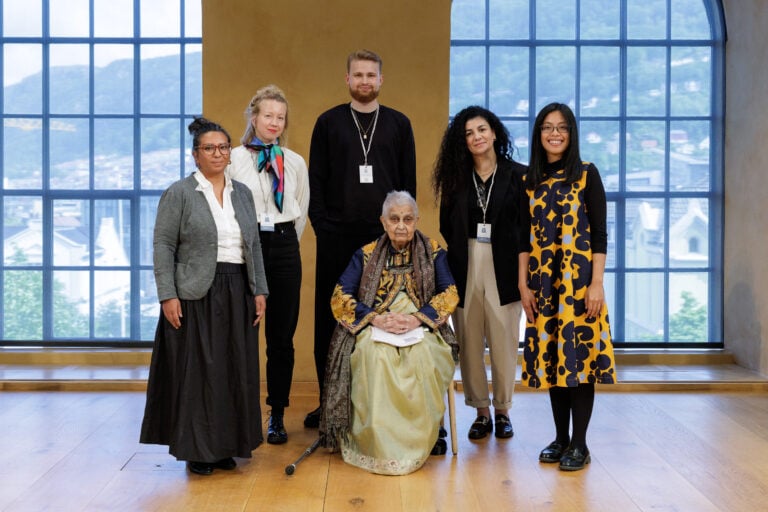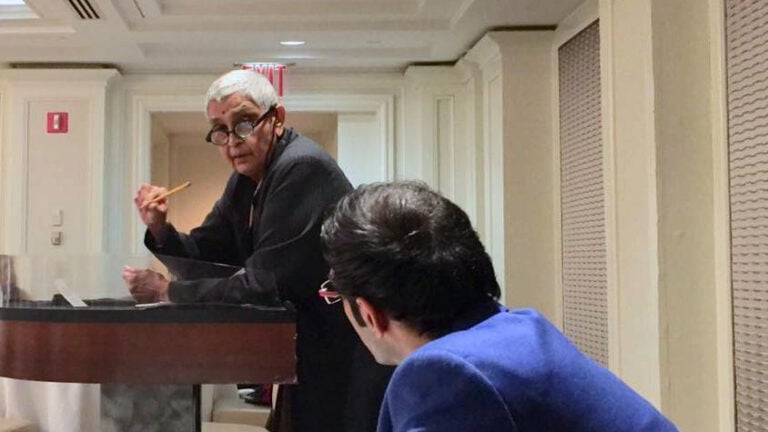Johannes Sartous presentation from the Masterclass with Holberg Laureate Gayatri Chakravorty Spivak on ‘The Practice of Learning’.
All disciplines produce knowledge and the students learn to know. The humanities – literature and philosophy – teach the practice of learning. In knowing, you know an object.
Introduction
On 4 June 2025, Five PhD candidates in the Nordic countries were invited to participate in a Masterclass with Holberg Laureate Gayatri Chakravorty Spivak on ‘The Practice of Learning’. Each of the participants gave a short presentation on the topic based on their research. The following text is a transcript from the presentation Johannes Sartou gave at the event.
Staging Silence: Subalternity, Imaginative Activism, and the Limits of Historiography
In her recent work, this year’s Holberg Prize laureate Gayatri Chakravorty Spivak reminds us that the humanities are not driven by efficiency or instrumental reason but by an altogether different imperative: the cultivation of what she calls “the practice of learning.” In Teaching for a Broken World (2024), she articulates this as an other-directed form of pedagogy—an “imaginative activism” that trains us to “go inside the text and try to wish what the text wishes, try to desire as the text desires.”[1] This orientation does not seek mastery or ownership of knowledge but entails a scrupulous effort to efface oneself, to be undone by the encounter with alterity.
History writing, I suggest, demands a similar disposition. The practice of writing history, particularly when undertaken ‘from below,’ requires that we suspend the authority of the historian’s voice and instead attempt, however partially, to inhabit perspectives shaped by political marginality. In what follows, I explore how Spivak’s concept of imaginative activism might inform a historiographical sensibility attuned to absence, erasure, and the limits of representation.
Can the Subaltern Be Heard? Voice, Power, and Representational Violence
Spivak’s enduring question—can the subaltern speak?—continues to haunt efforts to write history ‘from below.’ Her concern, formulated most directly in the essay “Can the Subaltern Speak?” (1988), is not with speech as such but with intelligibility: within dominant systems of knowledge and power, the subaltern subject is rendered structurally unhearable. When intellectuals claim to ‘give voice’ to the oppressed without interrogating their own position, they risk reproducing a representational violence whereby the subaltern is not heard but ventriloquized—used to reflect the speaker’s own transparency or virtue.[2]
This concern is sharpened by the anthropologist Michel-Rolph Trouillot’s intervention in Silencing the Past (1995), where he demonstrates that silences in historical narratives are not accidental gaps but the produced effects of power operating at every stage of historical production—from archival documentation to historiographical narration. Like Spivak, Trouillot insists that exclusion is not merely epistemic but systemic. What is left unsaid is never neutral.[3]
Taken together, these critiques challenge romanticized conceptions of ‘recovery’ in subaltern historiography. Writing history ‘from below,’ then, is not the act of retrieving voices waiting patiently in the archive. It is a confrontation with the very conditions that rendered those voices inarticulable or unintelligible. The task is not to ‘give voice’ to the subaltern but to mark the structures that refuse such voice.
My own research examines the historiographical formation of what has come to be known as “history from below” as it emerged and developed between the 1840s and the 1960s. Across this period, a recurring tension appears: from early romantic nationalists like the French historian Jules Michelet (1798-1874) to Marxist historians like E.P. Thompson (1924-1993), attempts to write history ‘from below’ have often been shaped by political desire. In Le Peuple (1846), Michelet cast ordinary people as the heroic revolutionary heart of the French nation–a romanticized symbol that unified the body politic while ignoring internal divisions of gender, race, and political dissent. Over a century later, Thompson’s The Making of the English Working Class (1963) depicted a self-constituting proletariat grounded in shared customs and collective action. Yet both figures were shaped by their authors’ politics. Thompson, for instance, was criticized by historians Perry Anderson and Joan Wallach Scott for idealizing the progressive (male) worker while neglecting conservative elements and erasing women’s roles.[4]
In both cases, these subject-formations become overdetermined; illustrating how the marginalized can become a ventriloquist’s doll for the historian’s politics. In other words, agency was as much constructed as recovered.
Between ‘The Subaltern’ and ‘The People’: The Politics of Historical Subjecthood
Spivak’s later writings offer critical insight into this representational dilemma. In “Scattered Speculations on the Subaltern and the Popular” (2005), she distinguishes between “the subaltern” and “the people,” warning that the latter “becomes a slogan too quickly.” While “the people” functions as a political signifier capable of rallying diverse actors, it also risks flattening difference and eliding exclusion. The subaltern, by contrast, is “contentless”—a structural position that defies identity until hegemonized or spoken for.[5] The aforementioned representational gesture of history ‘from below’ thus risks reinscribing the subaltern as absence, otherness, or rhetorical force by reducing the subaltern to a populist signifier instead of tracking their radical exclusion.
This distinction is crucial for historiography. The historiographical category of ‘the people’ is inherently unstable, subject to strategic resignification in response to shifting political contexts. As Michelet’s declaration in Le Peuple illustrates: “I am coming forward now against all these views to establish the personality of the people,” the historian does not merely describe but performs and constitutes their subject. From Michelet to Pyotr Kropotkin, from Anna Julia Cooper and C.L.R. James to the British Marxist historians, the identity of ‘the people’ is continuously rewritten: a national subject, a revolutionary multitude, a class actor, or a bearer of tradition. Each articulation responds not only to the past but to the present’s political exigencies— the 1848 revolutions, the 1905 uprisings in Russia, the interwar anticolonial ferment, and the mid-century antifascist and labour movements.
Staging Absence: Imaginative Activism Beyond Recovery
How, then, might one write history ‘from below’ without succumbing to these pitfalls? Here, I propose a renewed engagement with Spivak’s notion of ‘imaginative activism.’ Rather than a method of recovery, it is a mode of disciplined attention—a willingness to dwell with the opacity of the past, to stage historical silence without prematurely filling it.
As I have argued, attempts to recover subaltern agency are frequently shaped by political desires that risk overriding the very erasures they seek to contest. Imaginative activism calls for another approach. It insists that historians efface their own explanatory mastery, resisting the temptation to redeem or resolve absence through coherent narrative. It is, in this sense, a practice of staging—not just what was said, but what could not be heard, and why.
This practice can be seen in Trouillot’s reconstruction of the life of Colonel Sans Souci in Silencing the Past. Sans Souci—a former enslaved man who rose to prominence as a revolutionary commander—led independent military operations against French forces in the northern region of Saint-Domingue during the Haitian Revolution (1791-1804). He came into conflict with Henri Christophe, another Black officer in the revolutionary army, after refusing to subordinate his forces to Christophe’s authority. Despite sharing the broader goal of defeating the French, Sans Souci challenged Christophe’s leadership and the emerging hierarchical order within the revolutionary ranks. In 1803, Christophe lured Sans Souci into a supposed negotiation and had him assassinated. This act of internal purging was later obscured in dominant historical accounts, which favored a narrative of unified Black leadership. Trouillot does not attempt to ‘recover’ Sans Souci in a redemptive or heroic frame. Instead, he repositions scattered archival traces—colonial military reports, official correspondence, and elite historiography—to show that while Sans Souci’s story was always possible to tell, it was actively buried. As Trouillot writes, “The evidence required to tell his story was available in the corpus I studied, in spite of the poverty of the sources. I only reposition that evidence to generate a new narrative. My alternative narrative, as it develops, reveals the silences that buried, until now, the story of the colonel.”[6] This “new narrative” is not a completed biography but a method of revealing how silence functions in historical production. Trouillot foregrounds contradiction and absence—demonstrating how Sans Souci’s opposition to Christophe disrupted the myth of a unified revolutionary front and how post-revolutionary political needs shaped who would be remembered and who would be erased.[7]
What Trouillot stages, then, is not simply an omitted biography, but the very process by which marginalized figures become unthinkable. He reveals how silencing is produced—not only through archival omission, but through narrative convenience, ideological framing, and the erasure of internal dissent. His historiographical intervention enacts my appropriation of ‘imaginative activism’ for historiography: a critical practice that refuses to smooth over absence with coherence, and that makes the structure of historical exclusion itself the object of analysis.
To historicize the subaltern, as Spivak reminds us in “Scattered Speculations on the Subaltern and the Popular”, “is not to write the history of the singular. It is the active, scrupulous, and vigilant contamination of historiography.”[8] The historian’s task, therefore, is not to retrieve the subaltern as a unified subject but to expose the conditions of their structural absence. This requires confronting the limits of our own methods, vocabularies, and categories. It demands that we treat historiography itself not as a neutral vehicle but as a field shaped by power, ideology, and desire.
In this light, history ‘from below’ cannot be merely a redemptive project. It is, at its best, an act of critical fidelity to what resists representation; a rigorous practice of learning that confronts the violence of archival and historiographical production. It is in this unfinished space—between historical grasp and conceptual remainder—that the historian of the subaltern finds their most urgent and necessary task.
Bibliography
Anderson, Perry: Arguments Within English Marxism, Verso Books, 1980, p. 37
Scott, Joan Wallace: Gender and the Politics of History, Columbia University Press, revised edition 1999
Spivak, Gayatri Chakravorty: “Can the Subaltern Speak?” in Critique of Postcolonial Reason: Toward a History of the Vanishing Present (Cambridge, MA: Harvard University Press, 1999)
———. “Scattered Speculations on the Subaltern and the Popular.” Postcolonial Studies 8, no. 4 (2005): 475–86.
———. “Teaching for a Broken World.” ANGLICA: An International Journal of English Studies 33, no. 3 (2024): 11–26.
Trouillot, Michel-Rolph: Silencing the Past: Power and the Production of History, 1st ed., Boston: Beacon Press, 2015
Notes
[1] Spivak, Gayatri Chakravorty: “Teaching for a Broken World.” ANGLICA-An International Journal of English Studies 33.3 (2024), 11–26, p. 23
[2] Spivak, Gayatri Chakravorty: “Can the Subaltern Speak?” in Critique of Postcolonial Reason: Toward a History of the Vanishing Present (Cambridge, MA: Harvard University Press, 1999), p. 256.
[3] Trouillot, Michel-Rolph: Silencing the Past: Power and the Production of History, 1st ed., Boston: Beacon Press, 2015.
[4] Anderson, Perry: Arguments Within English Marxism, Verso Books, 1980, p. 37; & Scott, Joan Wallace: Gender and the Politics of History, Columbia University Press, revised edition 1999, p. 68–93
[5] Spivak, Gayatri Chakravorty: “Scattered Speculations on the Subaltern and the Popular.” Postcolonial Studies 8, no. 4 (2005): 475–86, p. 477
[6] Trouillot, Silencing the Past, p. 27
[7] Ibid., p. 31–70
[8] Spivak, “Scattered Speculations,” p. 484
Last edited:
Published:
About the author
Johannes Sartou
 Johannes Sartou. (Photo: Private.)
Johannes Sartou. (Photo: Private.)
Johannes Sartou is a PhD candidate in Intellectual History at Aarhus University, working on a dissertation titled Staging the Subaltern: The Making and Remaking of the Past from Below, which explores the emergence of a historiographical approach centering “forgotten voices” and popular agency.
For the masterclass, I will reflect on how subaltern agency in historiography is not simply recovered but actively constructed through the historian’s engagement with the past—an engagement that often carries political stakes. Approached as an act of imaginative activism—a practice of effacing oneself to enter the field of another’s desire—this approach may help resist reinscribing the subaltern as absence and keep open the potential of writing history ‘from below.’
Related content

“I Know What You Said and I Also Know What I Heard”: Creole Languages and the Case for a Humanistic Linguistics
Jillian Loise Melchors presentation from the Holberg Masterclass with Gayatri Chakravorty Spivak on 'The Practice of Learning'.

Representation and Responsibility: A Perspective on the Practice of Learning
Sabina Ivenäs' presentation from the Holberg Masterclass with Gayatri Chakravorty Spivak on 'The Practice of Learning'.

The Holberg Masterclass with Gayatri Chakravorty Spivak: ‘The Practice of Learning’
All disciplines produce knowledge and the students learn to know. The humanities – literature and philosophy – teach the practice of…

